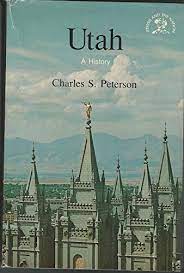Articles/Essays – Volume 11, No. 4
An Enduring History | Charles S. Peterson, Utah: A Bicentennial History
The States and the Nation Series is a set of histories of each state and the District of Columbia “designed to assist the American people in a serious look at the ideals they have espoused and the experiences they have undergone in the history of the nation.” The project was funded by the National Endowment for the Humanities and administered by the American Association for State and Local History as part of the bicentennial celebration. James Morton Smith, general editor of the series, requested that authors avoid the near-irresistible impulse to make a new scholarly statement. They should provide instead, he proposed, “a summing up—interpretive, sensitive, thoughtful, individual, even personal—of what seems significant about his or her state’s history.” Charles S. Peterson’s Utah: A Bicentennial History succeeds as a history to the extent that it ignores the first part of Smith’s instructions, offering in lively narrative a fresh and useful short history of Utah. The volume is solid and scholarly, its more personal interpretive passages obviously taking second place in the author’s mind to a serious intent to write an enduring volume.
Here and there Professor Peterson has taken unfelicitous liberties with the language. For example he says that Brigham Young and other leaders, during the exodus from Nauvoo, “in an explosion of activity . . . whipped together” the Camp of Israel (p. 32). Though in several instances such extravagance of expression seems unnecessary, the general reader, to whom the book is addressed, will no doubt find a net gain in the liveliness and color of the narrative thus offered. The colorful writing style does not obscure the underlying quality of a remarkably comprehensive and reliable survey of almost every aspect of early Utah history. Though the strict limits of space imposed by the editors lead the reader to wish one or another episode or theme could have been taken up more fully, it would be difficult to propose where the cut should be made to permit fuller treatment elsewhere.
Peterson places considerable emphasis on the nationalistic aims of Utah’s early leaders, using Thomas F. O’Dea’s phrase “near-nationalism” as a conceptual reference point from which to examine developments within the Mormon kingdom between 1860 and 1890. The phrase, regrettably, is not sufficiently versatile to do justice to Peterson’s sound insights and eventually loses its effect through repetition, detracting from an excellent discussion. The concept works well, but not the phrase. The denouement of the episode, as recounted in the volume, is the issuing of the Manifesto, marking, in a commonly held point of view, the transformation of Mormonism’s early reformist zeal to a staid me-too Americanism.
Peterson (and other writers) at this point turn their attention from Mormonism as such, and begin to look at economic developments, politics, and the growth of ethnic communities—noting in general, an increasing pluralism within Utah and a loss of distinctiveness compared with other western regions. Peterson makes an important point in this context, that rural Utah towns continued for many years to harbor a more-pristine Mormon culture than urban Salt Lake City, but fails to tie this to the theme of post-manifesto accommodation. In turning his eyes from Mormonism as a belief-system and as a distinctive social system, the author has failed to see in the everyday church life of involved Mormons the persistence of a pattern of culture every bit as reformist and deviant from American norms as was Mormonism in the 1890s. Peterson’s view, I hasten to add, is that of most scholars on the subject, but in failing to describe the Mormon belief system, he has closed for his readers the possibility of such an alternative interpretation.
Peterson has taken great pains to produce a balanced history. His chapter on the economics of nationalism offers the best short description available of economic developments in Utah toward the end of the nineteenth century. He gives deserved attention to the role of working men in the mining and smelting industries, describing the contract labor system used to bring immigrants to Utah from Eastern Europe and incidentally to enrich a few labor “czars” such as Leonidas Skliris. The chapter on “Other Utahs” offers a brief review of the development of various ethnic communities. A full twenty percent of the book deals with the twentieth century, perhaps much too little, but still far more than one is accustomed to seeing.
The volume contains a brief bibliography and sixteen-page “photographer’s essay” by Joe Munroe, with several fine photographs. The continuing dominance of the landscape in the face of human incursion is suggested in several of the frames. Taken as a group, however, the photographs seem to say little more than the traditional travel film cliche that Utah (or any region in the universe) is a land of contrasts.
In 1978, what enduring purpose is there in a bicentennial history? Many of the States and the Nation Series will probably have little lasting value, the more personal and introspective insights of the authors quickly dating them out of use. Professor Peterson, in this volume, however, has offered a history of Utah which, because it is less personal and is scholarly and concise, will serve to introduce the general reader to the colorful story of Utah’s past and to provide the more serious student of history a balanced review of the essential material.
Utah: A Bicentennial History. By Charles S. Peterson, New York: W. W. Nor ton & Co., 1977. $8.95.


 Back to full Issue
Back to full Issue

